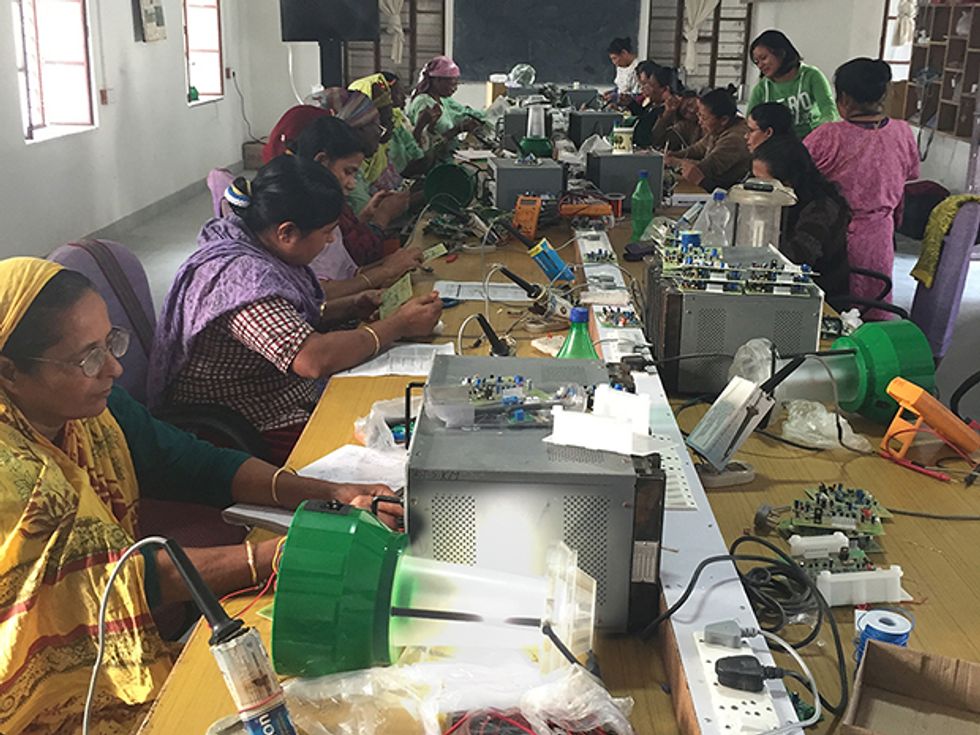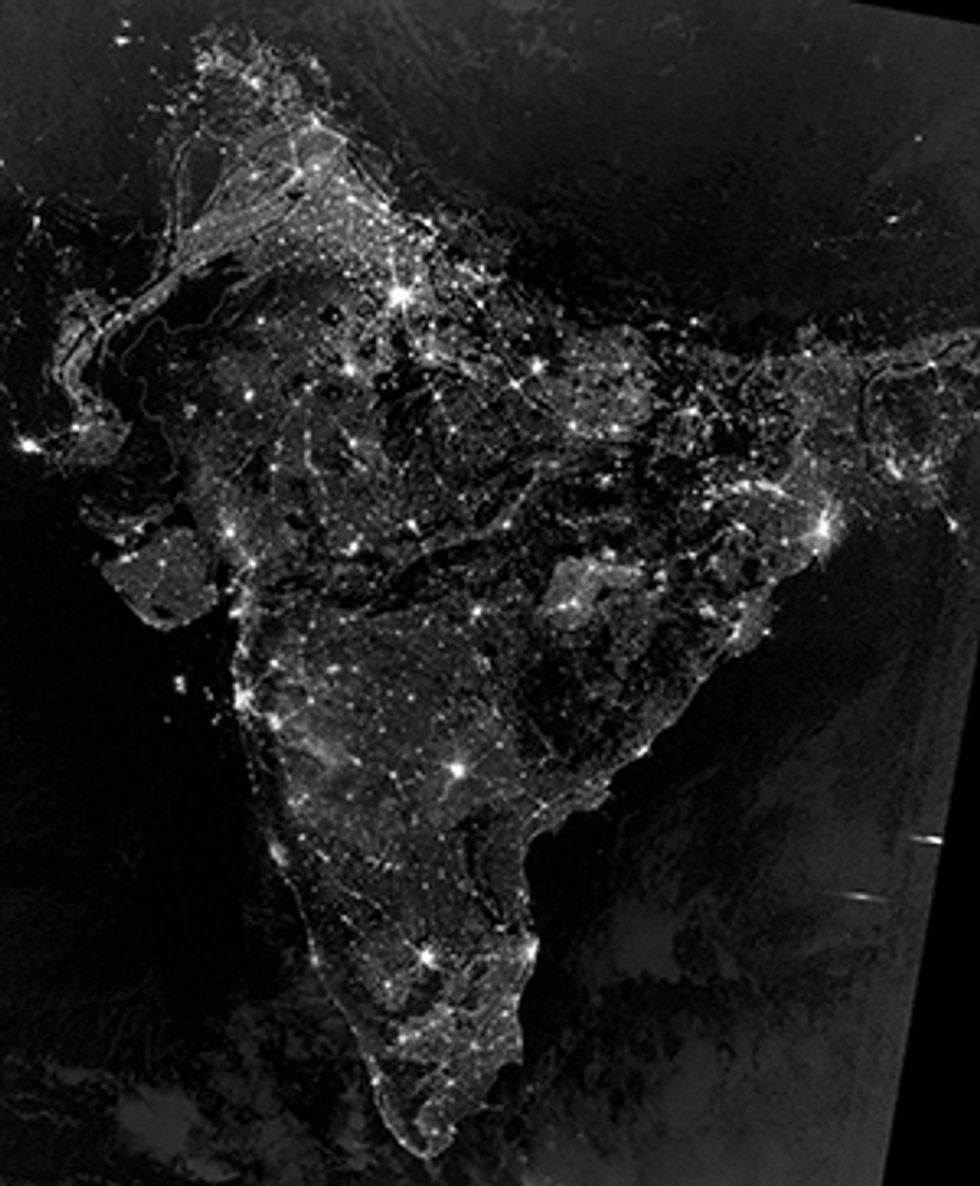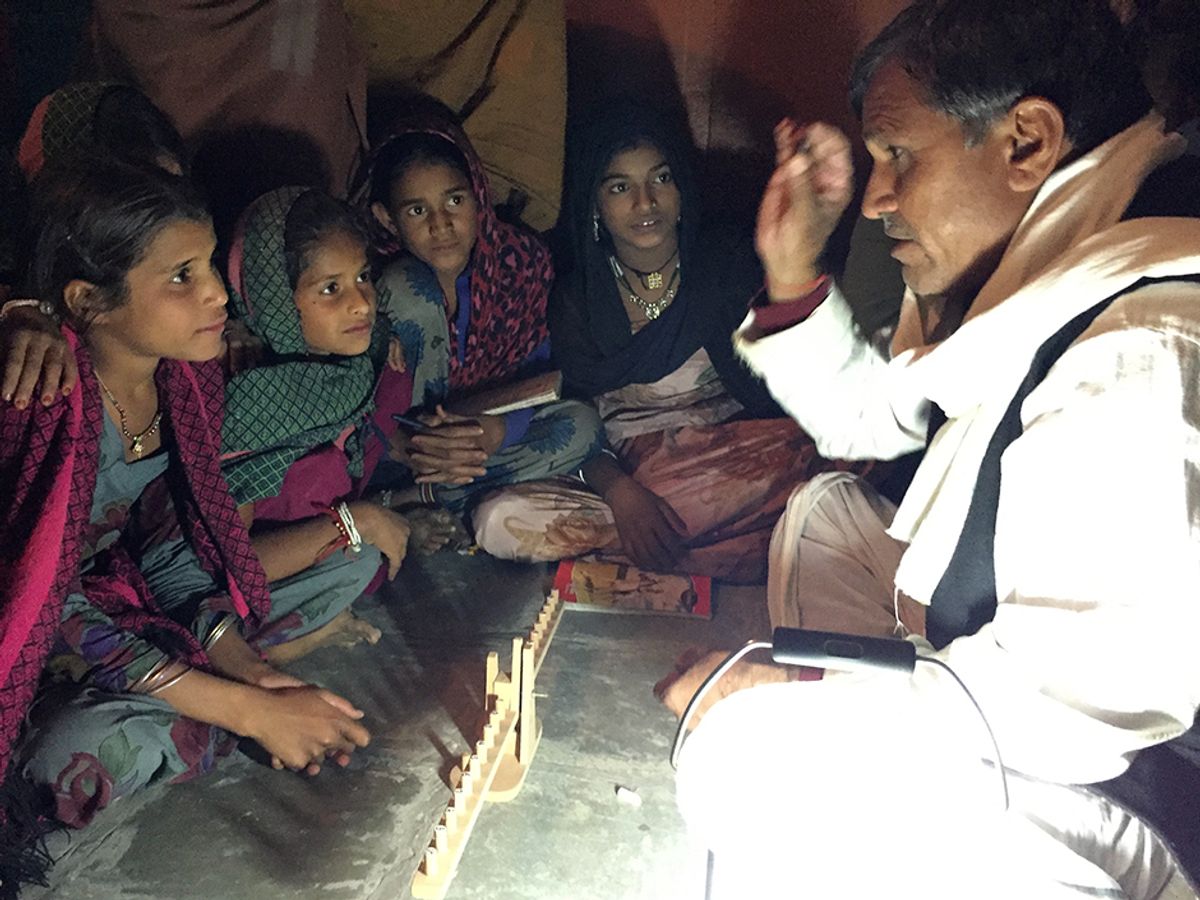The women wielding soldering irons in this rustic solar engineering workshop may not know how to read or write, but they know their way around their circuit boards. “This is the shunt coil,” Jansya Devi says, with a proud smile. “This is an eight-pin connector, and this is a drum coil.”
These technical words were not in Devi’s vocabulary a few months ago. She hails from Bihar, a state in eastern India known mainly for its rural poverty. Her village doesn’t get electricity from the national power grid, she says, and after dark she typically does her housework by the light of a kerosene lantern and candles. She dreads the monsoon season, when high winds make it difficult to keep the wicks lit. She has a mobile phone, but to charge it she has to send it along with someone making a trip to the nearest town.

Her situation will soon change, thanks to the Barefoot College, a nonprofit school that trains “barefoot solar engineers” like Devi, using color-coded parts and hands-on lessons. After six months at the peaceful campus in the northwestern state of Rajasthan, the new technicians will return to their home villages, bringing with them solar power equipment and know-how. They’ll install solar panels, charging stations, and small LED lights in houses, and they’ll stand ready to deal with breakdowns. While these systems offer only the most basic amenities of modern life, they also bring independence from India’s dysfunctional national power grid.
The program initially enrolled men, but these students proved disinclined to return to their villages once they had marketable skills. When the school began recruiting grandmothers instead, the program took off. As of 2015, the college’s graduates have brought light to some 20,000 houses in more than 300 villages across India, Barefoot administrators say. This very literal campaign of rural empowerment shows the untapped potential of women who are often passed over, says program manager Gloria Jonathan. “These women may be illiterate, but that doesn’t mean they’re uneducated,” she says. “They have skills and they have intelligence.”
The Barefoot College believes that such women can solve a very big problem. In India, 240 million people don’t have access to electricity, according to the 2015 report India Energy Outlook, from the International Energy Agency—and that’s a low estimate. A 2014 World Bank report put the figure at 300 million people. Yet the founder and director of Barefoot College, Bunker Roy, doesn’t sound daunted. His school’s decentralized and off-grid approach to providing electricity is “the only answer” for India, he says. “Mahatma Gandhi said the ultimate solution for fighting poverty in India was not mass production but production by the masses,” Roy says. “We have to apply the Gandhian model to solar-electrifying villages.”
A little light can make a big difference. At a “night school” run by the Barefoot College, kids who work on farms during the day learn by the glow of a solar-powered lantern.









India’s government, however, has a very different plan. Prime Minister Narendra Modi has pledged to give every citizen access to electricity by 2022. To meet this deadline, the government plans to rely heavily on solar power—but not off-grid projects run by local people. Last year, the Ministry of New and Renewable Energy announced an ambitious goal for building utility-scale solar facilities, including “ultra mega solar power projects” of 500 megawatts each, and establishing grid-connected rooftop solar projects in cities. With these two components, the government aims to reach 100 gigawatts of installed solar power capacity by 2022.
Many experts are frankly skeptical of the government’s ability to reach this goal, given that installed solar capacity in 2014 was less than 4 GW. Such a rapid scale-up will be “very difficult to achieve,” states a report by Bloomberg New Energy Finance, adding that the 100-GW goal may be more “aspirational” than realistic. The International Energy Agency report agrees, listing challenges relating to land acquisition, solar panel manufacturing, and finances. The report projects that by 2020 solar capacity will reach only 40 GW.

How the country solves its electrification problem is a pressing concern not only to rural Indians living in dark villages but to the whole world. India was estimated to account for 6 percent of global carbon dioxide output in 2014, and the country’s rapid economic growth could double its emissions by 2030. At the Paris climate change conference last December, Indian officials alternated between making bold promises to invest in solar power and claiming their right to continue building coal-fired power plants. India currently generates 61 percent of its electricity from coal, according to government reports. If the Indian government can’t meet its solar power pledges and provide clean electricity to all its citizens, the world’s best hope may be that those citizens will provide it for themselves.
The Barefoot College began itspioneering work to bring off-grid solar power to India’s villages in the 1990s. In the last decade it has been joined by similar philanthropic efforts as well as dozens of “social enterprise” companies, which operate microgrids or lease solar-powered lights to villagers in an effort to do good while making a profit.
The people who run these scrappy organizations have little faith in the government’s pledge to provide reliable grid power to all Indians. Debajit Palit, who directs the “Lighting a Billion Lives” project at the nonprofit Energy and Resources Institute, in New Delhi, notes that previous administrations have made such pledges, and that target dates have been repeatedly pushed back. Much of the delay comes from India’s chronically troubled electricity distribution companies, which have operated at a loss due mainly to low power prices and widespread electricity theft. These state-run utility companies together have accumulated US $65 billion (4.3 trillion rupees) in debts.
Last November, the central government approved a rescue plan for the distribution utilities that would clear their debts, freeing up resources to address the theft problem and improve infrastructure. It sounds good in theory, says Palit, “but the central government made the program, and the provincial governments have to implement it.” He’s seen enough mismanagement to question whether the state governments and companies will follow through with reforms.
Experts who study India’s electricity gap say these companies’ financial woes have not only stalled “last mile” efforts to electrify rural hamlets, they’ve also made grid power less attractive to everyone. The distribution companies often can’t afford to buy power from generation stations, making long power cuts an everyday occurrence in some parts of the country. “Many villagers think, ‘I won’t get electricity during peak hours, so why should I connect?’ ” says Palit. He believes that off-grid solar kits, although they provide only a few watts of electricity, are a better solution for India’s villages. “If I promise small, but keep my promise by providing a reliable supply, the villagers are happy,” he says.
However, the financial models of off-grid solar efforts have also come under scrutiny. At Barefoot, for example, the bulk of the funding needed to keep its campus running comes from government and philanthropic sources. So scaling up its solar lighting program would require more and more largesse. But program manager Jonathan says that dependency doesn’t extend to villages that already have their solar systems up and running, because each community pays its resident solar technician a small salary and funds her “rural electronics workshop.” This money would otherwise be spent on kerosene and other fuels, Jonathan says. “We consider this a sustainable model,” she says. “Even if we were to pull out, the community effort would still continue.”
Still, providing electric light to those 240 million Indians who currently live without it will require scalable solutions. Anant Sudarshan, India director of the Energy Policy Institute at the University of Chicago, says the Barefoot College isn’t the answer. “I don’t think it’s a great idea to throw money into something if we know it’s not going to be viable, in the long run, without a continuous injection of funds,” he says.
Sudarshan, who is based in New Delhi, has also studied social enterprise companies that offer off-grid solar power to rural villages. “Right now these companies are not doing very well, and they don’t have much hope of doing very well,” he says. His surveys of people living without electricity revealed that many weren’t willing to pay for the tiny set of solar powered lights that such companies offer; instead they want enough power to run appliances such as televisions, electric sewing machines, and refrigerators. Even those villagers who are willing to pay for a few lights often consider this arrangement a stopgap solution while they wait for grid power. “There may be a sweet spot where these businesses can run profitably for a little while, but it’s hard to find,” Sudarshan says.
Selco India is one of the companies often praised for its attempts to use for-profit solar lighting projects to lift rural Indians out of poverty. But company cofounder H. Harish Hande explains that the solar power kits are only one piece of the services his company offers villagers—and not the most important selling point. His team also helps villagers secure bank loans for the initial solar setup, and then helps them start entrepreneurial efforts to make profitable use of their new power. “People are not interested in electricity; they’re interested in what electricity can do,” Hande says. “They’re interested in running an electric sewing machine.”
His full-service and customized approach may seem difficult to scale up, but Hande believes the plan is more logical than waiting for the government to provide grid electricity to villagers and expecting economic gains to follow. “The grid actually defeats development in many ways,” he says. While the government’s efforts position the poor as consumers, he says, they should instead be valued as producers. “That’s the true way to solve poverty,” he says, “and solar energy is a very powerful tool in making that happen.”
Back at the Barefoot College, administrators have a similar vision for their solar engineering grandmas. When someone like Devi brings light to her dark village in Bihar, she’s giving her community “a starting point,” says project manager Jonathan. That village could theoretically run its equipment for 25 years before the solar panels give out, she says, but she guesses that young people growing up under those small lights will be dissatisfied with the meager power provided by the small solar kit. That doesn’t bother her a bit, Jonathan says. “We see that as a good sign because then they’ve begun to think, ‘We want more.’ ”
